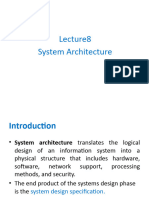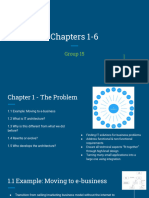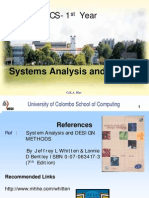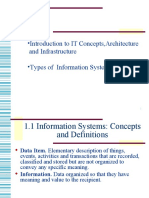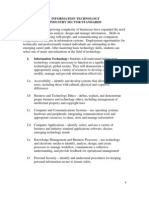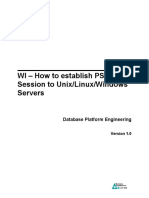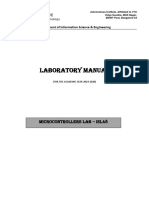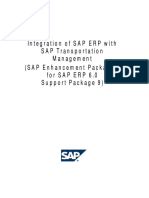System Architecture
Overview
• Chapter 8 is the final chapter in the systems design phase of
the SDLC.
• This chapter describes system architecture, which translates the
logical design of an information system into a physical blueprint.
• As you plan the system architecture, you will learn about servers,
clients, processing methods, networks, and related issues.
�Chapter Objectives
• Provide a checklist of issues to consider when selecting a system
architecture
• Describe servers, server-based processing, clients, and client-
based processing
• Explain client/server architecture, including tiers, cost-benefit
issues, and performance
• Compare in-house e-commerce development with packaged
solutions
3
�Chapter Objectives
• Discuss the potential impact of cloud computing and Web 2.0
• Explain the difference between online and batch processing
• Define network topology, including hierarchical, bus, ring, and star
models
4
�Chapter Objectives
• Explain network protocols and licensing issues
• Describe wireless networking, including wireless standards,
topologies, and trends
• Describe the system design specification
5
�Contents
• System architecture translates the logical design of an information
system into a physical structure that includes hardware, software,
network support, processing methods, and security.
• The end product of the systems design phase is the system design
specification.
�Introduction
• An effective system combines elements into an architecture, or
design, that is flexible, cost-effective, technically sound, and able
to support the information needs of the business
• System architecture translates the logical design of an information
system into a physical structure that includes hardware, software,
network support, and processing methods
7
�System Architecture Checklist
• Enterprise Resource Planning (ERP)
• The objective of ERP is to establish a company-wide strategy for using IT
resources
• Supply chain management (SCM)
• Initial Cost and TCO
• During the final design stage, you make decisions that will have a major
impact on the initial costs and TCO for the new system
• You should review all previous cost estimates
8
�System Architecture Checklist
• Scalability
• Scalability, also called extensibility, refers to a system’s ability to expand,
change or downsize easily to meet the changing need of a business
enterprise
• Especially important in implementing systems that are volume-rated,
such as transaction processing systems
9
� System Architecture Checklist
• Web Integration
• An information system includes
applications
• Web-centric architecture
• Avoids many of the connectivity
and compatibility problems that
typically arise
• E-marketplaces
10
�System Architecture Checklist
• Legacy System Interface Requirements
• The new system might have to interface with one or more legacy systems
• Interfacing a new system with a legacy system involves analysis of data
formats and compatibility
• The analyst must know if the new application eventually will replace the
legacy system
11
�System Architecture Checklist
• Processing Options
• In planning the architecture, designers also must consider how the
system will process data - online or in batches
• Provision must be made for backup and speedy recovery in the event of
system failure
12
�System Architecture Checklist
• Security Issues
– Security threats and defenses
are a major concern to a systems
analyst
– The analyst must consider
security issues that relate to
system design specifications
– Web-based systems introduce
additional security concerns
13
�Planning the Architecture
• Servers
• Server
• Clients
• Mainframe architecture
• Server-based processing
14
�Planning the Architecture
• Clients
• As PC technology exploded in the mid-1980s and 1990s, powerful
microcomputers quickly appeared on corporate desktops
• Users found that they could run their own word processing, spreadsheet,
and database applications
• Companies linked the stand-alone computers into networks
15
�Planning the Architecture
• Clients
• Stand-Alone Computing
• Local and wide area networks
• Client-based processing
16
�Client/Server Architecture
• Overview
17
�Client/Server Architecture
• Client/Server Design Styles
18
�Client/Server Architecture
• Fat and Thin Clients
19
�Client/Server Architecture
• Client/Server Tiers
– Two-tier design
– Three-tier design
• Middleware
– Enables the tiers to communicate and pass data back and forth
– Provides a transparent interface
– Can integrate legacy systems and Web-based applications
20
�Client/Server Architecture
• Cost-Benefit Issues
• Client/server systems enable the firm to scale the system in a rapidly
changing environment
• Client/server computing also allows companies to transfer applications
from expensive mainframes to less expensive client platforms
• Client/server systems reduce network load and improve response times
21
�Client/Server Architecture
• Client/Server Performance Issues
– In contrast to the centralized system, a client/server design separates
applications and data
– Distributed database management system (DDBMS)
– The system is scalable, so new data sites can be added without reworking
the system design
– The system is less likely to experience catastrophic failure
22
�Internet-Based Architecture
• Developing E-Commerce Solutions In-House
23
�Internet-Based Architecture
• Packaged Solutions and E-commerce Service Providers
• Many vendors offer turnkey systems for companies
• Another alternative is to use an application service provider (ASP)
• Another option is managed hosting
• Consider the experience of other companies in the same industry
24
�Internet-Based Architecture
• Corporate Portals
– A corporate portal can provide
access for customers,
employees, suppliers, and the
public
• Cloud Computing
– Effectively eliminates
compatibility issues
– Scaling on demand
– Requires significantly more
bandwidth
25
�Internet-Based Architecture
• Web 2.0
• Envisions a second generation of
the web that will enable people
to collaborate, interact, and
share information more
dynamically
• Wiki
• Internet operating system
26
�Processing Methods
• Online Processing
• Because it is interactive, online
processing avoids delays and
allows a constant dialog
between the user and the
system
• Online processing also can be
used with file-oriented systems
27
�Processing Methods
• Batch Processing
• The IT operations group can run batch programs on a predetermined
schedule, without user involvement, during regular business hours, at
night, or on weekends
• Require significantly fewer network resources than online systems
28
�Processing Methods
• Combined Online and Batch Processing
29
�Network Models
• The OSI Reference Model
• The OSI model consists of seven
layers
• Each layer performs a specific
function
• Offers a set of design standards
30
�Network Models
• Network Protocols
• In all cases, the network must use a protocol
• Transmission Control Protocol/Internet Protocol (TCP/IP)
• File Transfer Protocol (FTP)
31
� Network Models
• Network Topology
• Hierarchical network
• it mirrors the actual operational
flow in the organization
• One disadvantage of a hierarchical
network is that if a business adds
additional processing levels, the
network becomes more complex
and expensive to operate and
maintain
32
�Network Models
• Network Topology
• Bus network
• Devices can be attached or
detached from the network at any
point without disturbing the rest
of the network
• Overall performance declines as
more users and devices are added
• Today, the bus design is much less
popular
33
� Network Models
• Network Topology
• Ring network
• One disadvantage of a ring
network is that if a network device
fails (such as a PC or a server), the
devices downstream from the
failed device cannot communicate
with the network
• Multistation Access Unit (MAU)
34
�Network Models
• Network Topology
• Star network
• Disadvantage of the star design is
that the entire network is
dependent on the switch
• However, in most large star
networks, backup switches are
available immediately in case of
hardware failure
35
�Network Models
• Network Topology
• Mesh network
• While this design is extremely
reliable, it also is very expensive to
install and maintain
• Originally developed for military
applications
36
�Network Models
• Routers
• Routers differ from switches in
that they work at a higher OSI
level
• Can connect to a larger,
dissimilar network, such as the
Internet
• Gateway
• Proxy server
37
�Network Models
• Network Modeling Tools
• As you translate the OSI logical
model into a physical model of
the networked system, you can
use software tools
• Network Licensing Issues
• Software licensing restrictions
38
�Wireless Networks
• A wireless local area network, or WLAN
• Wireless Network Standards
• 802.11
• Institute of Electrical and Electronics Engineers (IEEE)
• Amendments
• Mbps (megabits per second)
39
�Wireless Networks
• Wireless Network Standards
• 802.11g
• 802.11n
• Multiple input/multiple output (MIMO)
• Multipath design
• 802.11y
40
�Wireless Networks
• Wireless Network Topologies
• Basic Service Set (BSS) – infrastructure mode
• Access point
• Extended Service Set (ESS)
• Roaming
• Independence Service Set (ISS) – peer-to-peer mode
41
�Wireless Networks
• Wireless Trends
• Wi-Fi Alliance
• Wi-Fi (wireless fidelity)
• BlueTooth
• On addition to 802.11 protocols for LANs, IEEE is working on 802.16
standards
• MANs (metropolitan area networks)
• WiMAX
42
�Systems Design Completion
• System Design Specification
• A typical system design specification uses a structure similar to the
following:
1. Management summary
2. System components
3. System environment
4. Implementation requirements
5. Time and cost estimates
6. Additional material
43
�Systems Design Completion
• User Approval
– Users must review and approve the interface design, report and menu
designs, data entry screens, source documents, and other areas of the
system that affect them
– Other IT department members also need to review the system design
specification
– When the system design specification is complete, you distribute the
document to a target group of users, IT department personnel, and
company management
44
�Systems Design Completion
• Presentations
– The first presentation is to the systems analysts, programmers, and
technical support staff members
– Your next presentation is to department managers and users from
departments affected by the system
– The final presentation is for company management
– Management might reach one of three decisions: proceed with systems
development, perform additional work on the systems design phase, or
terminate the project
45
�Chapter Summary
• An information system combines hardware, software, data,
procedures, and people into a system architecture
• The analyst must consider enterprise resource planning, initial
cost and TCO, scalability, Web integration, legacy interface
requirements, processing options, and security issues
• An architecture requires servers and clients
46
�Chapter Summary
• Compared to file server designs, client/server systems are more
scalable and flexible
• In implementing a design, an analyst should consider e-commerce
strategies, the availability of packaged solutions, and corporate
portals, which are entrances to a multifunction Web site
• The primary processing methods are online and batch processing
47
�Chapter Summary
• Networks allow the sharing of hardware, software, and data
resources in order to reduce expenses and provide more
capability to users
• The way a network is configured is called the network topology
• The system design specification presents the complete systems
design for an information system
• Chapter 8 complete
48
�Question & Answers

